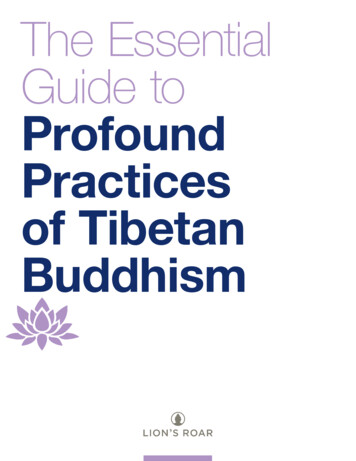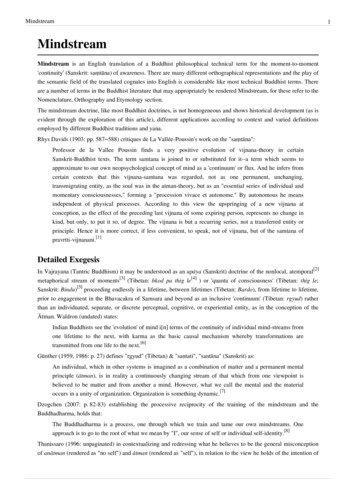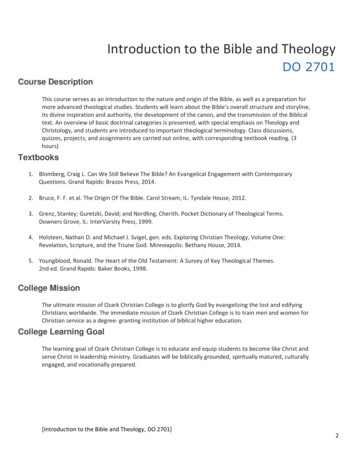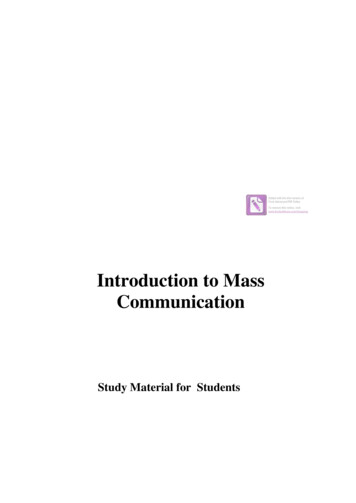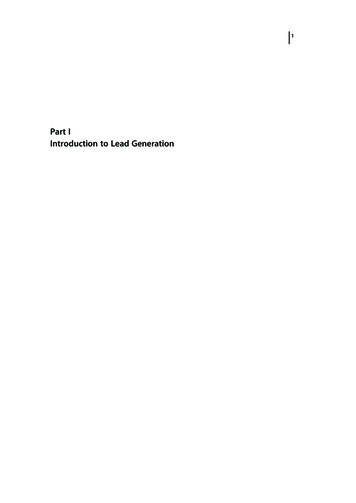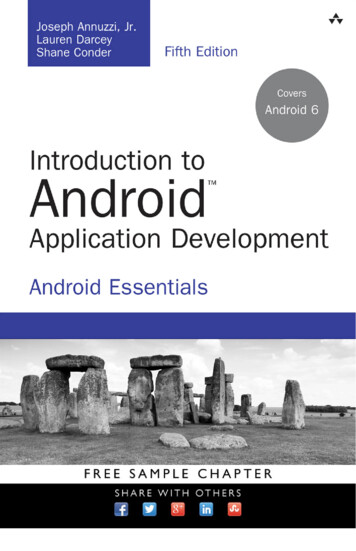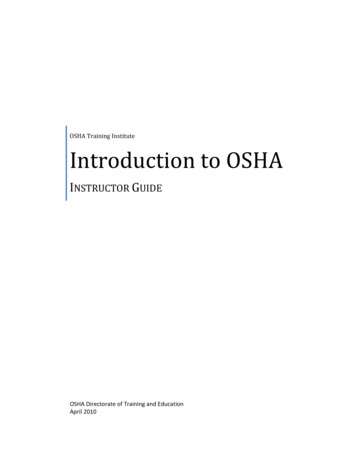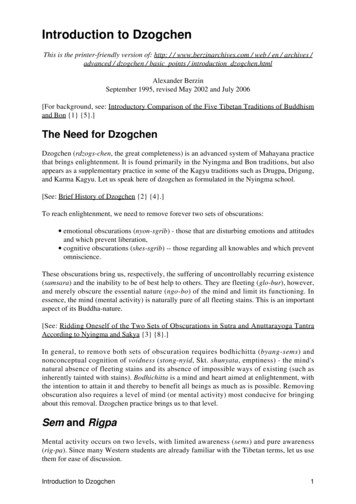
Transcription
Introduction to DzogchenThis is the printer-friendly version of: http: / / www.berzinarchives.com / web / en / archives /advanced / dzogchen / basic points / introduction dzogchen.htmlAlexander BerzinSeptember 1995, revised May 2002 and July 2006[For background, see: Introductory Comparison of the Five Tibetan Traditions of Buddhismand Bon {1} {5}.]The Need for DzogchenDzogchen (rdzogs-chen, the great completeness) is an advanced system of Mahayana practicethat brings enlightenment. It is found primarily in the Nyingma and Bon traditions, but alsoappears as a supplementary practice in some of the Kagyu traditions such as Drugpa, Drigung,and Karma Kagyu. Let us speak here of dzogchen as formulated in the Nyingma school.[See: Brief History of Dzogchen {2} {4}.]To reach enlightenment, we need to remove forever two sets of obscurations: emotional obscurations (nyon-sgrib) - those that are disturbing emotions and attitudesand which prevent liberation, cognitive obscurations (shes-sgrib) -- those regarding all knowables and which preventomniscience.These obscurations bring us, respectively, the suffering of uncontrollably recurring existence(samsara) and the inability to be of best help to others. They are fleeting (glo-bur), however,and merely obscure the essential nature (ngo-bo) of the mind and limit its functioning. Inessence, the mind (mental activity) is naturally pure of all fleeting stains. This is an importantaspect of its Buddha-nature.[See: Ridding Oneself of the Two Sets of Obscurations in Sutra and Anuttarayoga TantraAccording to Nyingma and Sakya {3} {8}.]In general, to remove both sets of obscuration requires bodhichitta (byang-sems) andnonconceptual cognition of voidness (stong-nyid, Skt. shunyata, emptiness) - the mind'snatural absence of fleeting stains and its absence of impossible ways of existing (such asinherently tainted with stains). Bodhichitta is a mind and heart aimed at enlightenment, withthe intention to attain it and thereby to benefit all beings as much as is possible. Removingobscuration also requires a level of mind (or mental activity) most conducive for bringingabout this removal. Dzogchen practice brings us to that level.Sem and RigpaMental activity occurs on two levels, with limited awareness (sems) and pure awareness(rig-pa). Since many Western students are already familiar with the Tibetan terms, let us usethem for ease of discussion.Introduction to Dzogchen1
Introduction to Dzogchen Sem is mental activity limited by fleeting stains. Rigpa is mental activity devoid of all fleeting stains of obscuration.Sem may be conceptual or nonconceptual and, in either case, is always stained. Rigpa, on theother hand, is exclusively nonconceptual, in a purer manner than is nonconceptual sem, and isnever stained by either of the two sets of obscurations.Since mental activity, whether limited or pure, is naturally devoid of fleeting stains, rigpa isthe natural state of sem. Thus, rigpa, with its essential nature of being devoid of all stains, canbe recognized as the basis of each moment of our cognition.Dzogchen, then, is a method of practice, grounded in bodhichitta and nonconceptual cognitionof voidness, enabling us to recognize rigpa and stay forever at its level of mental activity freefrom all obscuration. In this way, rigpa's "great completeness" (dzogchen) of all enlighteningqualities for benefiting others becomes fully operational.Equivalency in Non-Dzogchen SystemsThe non-dzogchen systems of Gelug, Sakya, and Kagyu analyze three levels of mind ormental activity:1. Gross mental activity is sensory cognition, which is always nonconceptual.2. Subtle mental activity includes both conceptual and nonconceptual mental cognition.3. The subtlest mental activity underlying them all is clear light ( 'od-gsal), which isexclusively nonconceptual, but subtler than gross or subtle nonconceptual mentalactivity.Sutra and the lower classes of tantra employ subtle mental activity for the cognition ofvoidness. Only anuttarayoga, the highest class of tantra, accesses and uses clear light mentalactivity for this purpose.Parallel to this presentation, sutra and the lower classes of tantra in the Nyingma systememploy sem for the cognition of voidness. Only dzogchen accesses and uses rigpa for thispurpose.The non-dzogchen systems explain that subtlest clear light mind manifests at the moment ofdeath. A facsimile of it manifests for an instant when experiencing orgasm, falling asleep,fainting, sneezing, and yawning. At such times, the grosser energy-winds (rlung, Skt. prana,"lung") that support gross and subtle mental activity temporarily cease (dissolve), thustemporarily stopping these two levels of mental activity and enabling the clear light level tofunction.To gain stable control of clear light mental activity, however, requires accessing this level inmeditation. We accomplish this with anuttarayoga complete stage practices (rdzogs-rim,completion stage) of working with the body's subtle energy system to dissolve theenergy-winds. As a cause for success on the complete stage, we imagine the dissolutionprocess on the generation stage (bskyed-rim), modeled after the stages of death, bardo, andrebirth.Sem and Rigpa2
Introduction to DzogchenWith the dzogchen methods, we recognize and access the subtlest mental activity - in thiscase, rigpa - without need to dissolve the energy-winds as the method for gaining access. But,how to recognize rigpa?Definition of MindMind, in Buddhism, refers to mental activity, not to a "thing" that is the agent of that activityor to a "tool" that a "me" uses to engage in that activity. The definition of mind describes theactivity from two points of view. Thus, the two aspects of the description are simultaneousfunctions, not sequential:1. the mental activity of producing or giving rise (' char-ba) to cognitive appearances(snang-ba),2. the mental activity of cognitively engaging (' jug-pa) with cognitive appearances.The former is usually translated as clarity (gsal) and the latter as awareness (rig).Cognitive appearances do not refer to appearances of things "out there," which we may ormay not notice and cognize. They refer to how things appear "to the mind" when we cognizethem. In a sense, they are like mental holograms. For example, in nonconceptual sensorycognition such as seeing, colored shapes appear, which are merely mental representations(snang-ba, mental semblances) or mental derivatives (gzugs-brnyan, mental reflections) ofone moment of colored shapes. In conceptual cognition, a mental representation appears of theconventional object, such as a hand, that the colored shapes in that moment are the visualsensibilia of. A sequence of mental representations of a hand each second one inch further tothe right appears as motion. In other words, cognitive appearances exist only within thecontext of mental activity. They do not need to be clear or in focus.Moreover, cognitive appearances do not refer merely to the images that appear "in the mind"when cognizing visible objects with our eyes. They also refer to the cognitive appearances orarisings (shar-ba) of sounds, smells, tastes, physical sensations, thoughts, emotions, and so on.After all, it is mental activity that makes a sequence of consonant and vowel sounds arise aswords and sentences.Note that the expressions "things appear to the mind" or "in the mind" are merely manners ofspeaking particular to the English idiom and reflect a dualistic concept of mind totallydifferent from the Buddhist model.Cognitively engaging with cognitive appearances may be in any manner, such as seeing,hearing, thinking, or feeling them, and does not need to be conscious or with understanding. Itmay include ignoring something and being confused about it.The definition also adds the word mere (tsam), which implies that mental activity occurswithout a concrete agent "me" making it happen. It also implies that fleeting stains are not thedefining characteristic of this activity. The superficial (kun-rdzob, conventional) nature ofmental activity is merely producing and engaging with cognitive appearances; its deepest(don-dam, ultimate) nature is its voidness.Further, mental activity is individual and subjective. My seeing of a picture and my feeling ofhappiness are not yours. Moreover, Buddhism does not assert a universal mind that we all arepart of, that we all can access, or that our mental continuums (mind-streams) merge with whenEquivalency in Non-Dzogchen Systems3
Introduction to Dzogchenwe achieve liberation or enlightenment. Even when enlightened, each Buddha's mentalcontinuum retains its individuality.The Differences between Mahamudra and DzogchenWhether on the gross, subtle, or subtlest clear light level, the nature of mental activity remainsthe same. Mahamudra (phyag-chen, great seal) practice, found in the Kagyu, Sakya, andGelug/Kagyu traditions, focuses on this nature. The Kagyu and Gelug/Kagyu traditions haveboth sutra and anuttarayoga tantra levels of the practice, while Sakya only an anuttarayogaone. In other words, Sakya mahamudra focuses only on the nature of clear light mentalactivity, while the other two traditions include focus on the nature of the other levels of mentalactivity as well.Rigpa shares the same nature as the three levels of mental activity analyzed by thenon-dzogchen schools. Dzogchen practice, however, is exclusively done on the highest levelof tantra and deals only with the subtlest level of mental activity. Moreover, dzogchen doesnot focus merely on the conventional and deepest natures of rigpa, but also on its variousaspects and facets.The Differences between Rigpa and Clear LightFurther, rigpa is not an exact equivalent of clear light. Rather, it is a subdivision of it.Different Degrees of Being Unstained The clear light level of mind is naturally devoid of grosser levels of mental activity,which are the levels at which conceptual cognition and the fleeting stains of disturbingemotions and attitudes occur. Before enlightenment, however, clear light mentalactivity is not devoid of the habits of grasping for true existence, which may beimputed or labeled on it. Nevertheless, when clear light is manifest, these habits do notcause clear light activity to make discordant (dual) appearances of true existence(gnyis-snang), nor do they prevent it from cognizing the two truths simultaneously(appearances and voidness), which they do when grosser levels of mind are active. Rigpa, on the other hand, is devoid of even the habits of grasping for true existence. Itis the totally unstained natural state of the mind.Difference in Terms of RecognizabilityClear light mental activity and rigpa are similar in the sense that when each is operating,grosser levels of mental activity are not functioning simultaneously. To access and recognize clear light mind requires actively stopping the grosser levelsof mental activity, through dissolving the energy-winds that support those levels. Rigpa is recognizable without actively stopping the grosser levels of mental activityand of energy-wind as the method to recognize it. When recognized and accessed,however, the grosser levels automatically stop functioning.Definition of Mind4
Introduction to DzogchenDifference in Terms of Reflexive Deep Awareness The non-dzogchen systems, particularly Gelug, differentiate object clear light (yul)from cognitive (yul-can, subject) clear light. Object clear light is the actual void nature(chos-nyid) of clear light, while cognitive clear light is clear light mental activity itself,a phenomenon that has object clear light as its nature (chos-can).Clear light mental activity is not necessarily aware of its own void nature, for examplethe clear light mind experienced at the moment of ordinary death. Even when thefifteenth-century Gelug master Kaydrub Norzang-gyatso (mKhas-grub Nor-bzangrgya-mtsho) explains that clear light mental activity naturally gives rise to a cognitiveappearance resembling that which arises in nonconceptual cognition of voidness, stillit does not automatically arise with an understanding of voidness, also as in ordinarydeath. Moreover, even when reflexive deep awareness (rang-rig ye-shes) of its ownvoid nature is presented as a natural quality of clear light, as in the Sakya and Kagyusystems, still it is not always operational, also as in ordinary death. Therefore,anuttarayoga practice aims at achieving, in meditation, cognitive clear light that isfully aware of its own object clear light nature. Rigpa, on the other hand, is innately aware of its own void nature. When we access it,it automatically is fully aware of its own nature. In dzogchen terms, it knows its ownface (rang-ngo shes-pa).Effulgent and Essence RigpaOn the path, we try to recognize two types of rigpa: first, effulgent rigpa (rtsal-gyi rig-pa) andthen, essence rigpa (ngo-bo'i rig-pa) underlying it.1. Effulgent rigpa is the aspect of rigpa actively giving rise to cognitive appearances.2. Essence rigpa is the cognitive open space (klong) or cognitive sphere (dbyings) thatunderlies and allows for actively producing and actively cognizing cognitiveappearances.Both types of rigpa are still rigpa, meaning that both are mental activities: the naturally pure,unstained awareness of something.The Relation of Cognitive Appearances and RigpaCognitive appearances are the play (rol-pa, display) of essence rigpa. When cognized withsem, they appear not to exist in this manner, and thus appearances are deceptive.Here, appearances as the play of some type of mental activity does not mean: that appearances arise due to the karma collected by the mind, or exist merely as whatcan be mentally labeled by the mind, as in the Gelug usage of the term play of themind, that all phenomena exist only in the mind, as in the extreme position of solipsism, that the cognitive appearance of a table and the visual consciousness of it come fromthe same natal source (rdzas) - namely, the same karmic legacy (sa-bon, seed, karmictendency) - despite the fact that the table is still made of atoms and has true unimputedexistence (it is not merely an imagined table), as in the Chittamatra explanation.Difference in Terms of Reflexive Deep Awareness5
Introduction to DzogchenRather, it means that the cognitive appearance of the table is something that rigpa gives rise toas its functional nature (rang-bzhin). In other words, what rigpa naturally does is tospontaneously establish (lhun-grub) cognitive appearances and, in this sense, cognitiveappearances are a play of the mind.Unlike the Chittamatra formulation, however, according to dzogchen, the table itself has itsown natal source - for example, the wood and atoms that comprise it. Moreover, the tablelacks true unimputed existence (bden-par ma-grub-pa). It exists as a table inasmuch as it canbe validly mentally labeled a table. Ultimately, however, its mode of existence is beyondwords and concepts, as in the non-Gelug Madhyamaka explanation.The dzogchen formulation of appearances as the play of the mind often employs Chittamatraterminology, such as alaya (kun-gzhi, basis for all) and eight types of consciousness.However, it does not explain them as existing in the same manner as the Chittamatra systemdoes. The usage of this terminology derives from the fact that Shantarakshita andKamalashila, the two earliest Indian masters of Buddhist logic to teach in Tibet, who providedthe sutra philosophical basis for Nyingma, taught a form of Madhyamaka that usesChittamatra terms. The Gelug tradition calls this form "theYogachara-Svatantrika-Madhyamaka school."[See: Brief History of Dzogchen {2} {4}. See also: Introductory Comparison of the FiveTibetan Traditions of Buddhism and Bon {1} {5}.]Voidness MeditationThe void nature of rigpa is its essential nature (ngo-bo) and is called its primal purity(ka-dag).Various Tibetan traditions of dzogchen, and masters within each tradition, have explained theprimal purity of rigpa in terms of self-voidness (rang-stong), other-voidness (gzhan-stong), orboth. Longchenpa (Klong-chen Rab-'byams-pa Dri-med 'od-zer), for example, made noreference to other-voidness. There are two interpretations of the position of Mipam ('Ju Mi-pham 'Jam-dbyangsrnam-rgyal rgya-mtsho), made by two wings of his disciples. Botrul (Bod-sprul) andKenpo Zhenga (mKhan-po gZhan-dga') present Mipam as asserting self-voidness,while Zhechen Gyeltsab (Zhe-chen rGyal-tshab Pad-ma rnam-rgyal) and Katog Situ(Kah-thog Si-tu) present him as asserting other-voidness. The first group is mostly atDzogchen Monastery (rDzogs-chen dGon-pa), while the second is mostly at ZhechenMonastery (Zhe-chen dGon-pa). There is no pervasion, however, that all masters ateach of these monasteries share this interpretation and assert the corresponding view.Moreover, they have given varying definitions of self and other-voidness. Let us stay with themost commonly accepted definitions in Nyingma.Self-voidness is the absence of an impossible way of existing, such as true unimputedexistence and, beyond that, existence that corresponds to what words and concepts imply.Other-voidness is the absence from rigpa of all grosser levels of mental activity and taintedstains.The Relation of Cognitive Appearances and Rigpa6
Introduction to Dzogchen[See: Making Sense of Tantra: Part II, Chapter 7 {6}.]Thus, the presentation of primal purity in terms of self-voidness is roughly equivalent to thenon-dzogchen systems' presentation of object clear light. The presentation in terms ofother-voidness is roughly equivalent to that of cognitive clear light. Regardless of in whichway it is presented and what terminology is used, primal purity is both self and other-void.Meditation on the primal purity of rigpa, whether or not presented in terms of other-voidness,entails focus on rigpa as a cognitive state devoid of all grosser levels and of all fleeting stains.It is innately aware of its own primal purity.Thus, voidness meditation in dzogchen does not entail analytical meditation on self-voidness.Neither does non-dzogchen object clear light meditation, for which we merely recall ourunderstanding of self-voidness previously gained through analytical meditation.Dzogchen meditation, however, does not entail any type of focus on the self-voidness of rigpa.Although analysis of self-voidness comprises part of the training required before attemptingthe practice of dzogchen, self-voidness is only understood at the time of rigpa meditation aspart of the primal purity that rigpa is innately aware of. Further, when we focus on cognitiveappearances being the natural play of rigpa, this implies that we have already understood theirself-voidness. If cognitive appearances are the natural play of rigpa, they cannot exist in themanner that the words and concepts for the appearances imply. Words and concepts imply thatthings truly and independently exist in fixed concrete boxes as "this"s and "that"s, but this isan impossible mode of existence. There is no such thing.Rigpa Is Complete with All Good QualitiesBasis rigpa (gzhi'i rig-pa) is the working basis of pure awareness. It is unobstructed andall-permeating (zang-thal) in the sense that it permeates all sem without obstruction, likesesame oil permeates sesame seeds, despite the fact that we do not recognize it. Thus, rigpa isan aspect of Buddha-nature and, according to dzogchen, it is complete with all good qualities(yon-tan, Buddha-qualities), such as omniscience and all-encompassing compassion. Rigpa isanalogous to the sun, and just as the sun cannot exist separately from the qualities of the sun,such as light and warmth, similarly rigpa does not exist separately from the Buddha-qualities.Thus, when we access essence rigpa in meditation and it becomes operational, we do not haveto add on top of it the Buddha-qualities. We do not need to actualize on top of it a mind ofomniscient awareness or of all-encompassing compassion. It is naturally and spontaneously(lhun-grub) there.Comparison with the Gelug, Sakya, and SamkhyaPositionsThe Gelug and Sakya explanations of Buddha-nature assert that the Buddha-qualities existnow merely as potentials (nus-pa) of clear light mental activity. They are like seeds, which aredifferent from the soil in which they are found. We need to cultivate them so that they grow.Although the non-Buddhist Samkhya school of Indian philosophy does not assertBuddha-nature or Buddha-qualities, a Samkhya-style presentation of this point would be thatomniscience is ultimately findable already functioning in clear light mental activity. It isVoidness Meditation7
Introduction to Dzogchenmerely not manifest presently.The dzogchen position is neither of these. We cannot say that rigpa in its present obscuredstate is operating as an omniscient awareness. Presently, rigpa is obscured by fleeting stainsand flowing together with an automatically arising (lhan-skyes) factor of dumbfoundedness(rmongs-cha, stupidity, bedazzlement). Because of dumbfoundedness, rigpa does notrecognize its own face and, consequently, it is not operational. It functions instead as an alayafor habits (bag-chags-kyi kun-gzhi) - foundational awareness for the habits of grasping for trueexistence, for karma, and for memories.Therefore, dzogchen emphasizes the importance of preliminary practices (sngon-'gro,"ngondro") and of strengthening the two enlightenment-building networks of positive forceand deep awareness (collections of merit and insight) as strongly as the Gelug, Sakya, andnon-dzogchen Kagyu traditions emphasize them. The purpose, however, is not for building upgood qualities or for actualizing potentials for these qualities, but for eliminating obscurationsthat prevent rigpa from recognizing its own face. The "face" of rigpa is characterized asSamantabhadra (Kun-tu bzang-po): literally, all-excellent. Such recognition will not happenall by itself, without any causes.The Meaning of Rigpa Being PermanentWhen the dzogchen texts assert that rigpa is an unaffected (' dus-ma-byed, unconditioned,uncollected) permanent (rtag-pa) phenomenon, we must understand the meaning carefully.Unaffected, here, means that it is not created anew each moment and does not organicallygrow from something, as a sprout does from a seed. Thus, it is uncontrived (bcos-med) - notmade up or fabricated, under the influence of causes and conditions, as something temporaryand new. Moreover, its having good qualities does not depend on causes and conditions. It ispermanent, not in the sense of being static and not performing a function, but rather in thesense of lasting forever, as do its qualities.In each moment, however, rigpa spontaneously gives rise to and is aware of different objects.In this sense, it is fresh and clean (so-ma). Although its nature never changes, these aspectschange. Focusing on this feature, Gelug would assert that rigpa is nonstatic (mi-rtag-pa,impermanent). There is no contradiction, however, because dzogchen and Gelug are definingand using the terms permanent and impermanent differently.[See: Static and Nonstatic Phenomena {7}.]Those Who Progress in Stages and Those for Whom ItHappens All at OnceThere are two types of dzogchen practitioners: those who progress in stages (lam-rim-pa) andthose for whom it happens all at once (cig-car-ba). This differentiation regards the manner ofproceeding to enlightenment for practitioners once they have realized essence rigpa. In otherwords, it regards those who have become aryas (' phags-pa, highly realized beings) with theattainment of a seeing pathway mind (mthong-lam, path of seeing) and the true stopping of theemotional obscurations.Those who progress in stages proceed through the arya bodhisattva ten bhumi levels of minds(sa, Skt. bhumi), one by one, gradually removing the cognitive obscurations.Comparison with the Gelug, Sakya, and SamkhyaPositions8
Introduction to DzogchenThose for whom it happens all at once achieve a true stopping of both sets of obscuration all atonce with the first realization of essence rigpa. Thus, they become aryas and Buddhassimultaneously.[See: Ridding Oneself of the Two Sets of Obscurations in Sutra and Anuttarayoga Accordingto Nyingma and Sakya {3} {8}.]Although dzogchen texts usually speak more of the second variety, only a tiny fraction ofpractitioners is of this type. Their elimination of both sets of obscuration with the firstrealization of essence rigpa is due to the enormous amount of positive force (merit) they havebuilt up with bodhichitta and dzogchen practice in previous lives. That positive force may alsoenable them to proceed through the stages before achieving a seeing pathway mind morequickly than most. Nevertheless, no one asserts the attainment of enlightenment without thebuildup of vast networks of positive force and deep awareness, from intense practice ofpreliminaries, meditation, and bodhisattva conduct - even if the majority of this has occurredin previous lifetimes.Therefore, when dzogchen texts refer to the recognition of rigpa as the one that cuts off all forcomplete liberation (chig-chod kun-grol, the panacea for complete liberation), we need tounderstand this correctly. For those for whom it happens all at once, the first realization ofessence rigpa is sufficient for cutting all obscurations for the complete attainment ofenlightenment. This does not mean, however, that realization of rigpa is sufficient by itself forattaining enlightenment, without need for any preliminaries, such as bodhichitta orstrengthening the two enlightenment-building networks, as the causes for achieving thatrealization.Contrast with Gradual and Sudden Enlightenment asAsserted in Chinese BuddhismSeveral traditions of Chinese Buddhism differentiate between gradual and suddenenlightenment. The two do not correspond to the dzogchen distinction between the manner ofpractice for those who progress in stages and those for whom it happens all at once. Gradual enlightenment (tsen-min) entails working, in graded steps, with samsaricmental activity to gain liberation from samsara. Sudden enlightenment (ston-mun) derives from the view that it is impossible to gainliberation from samsara by using samsaric mental activity. We need to make a totalbreak from that level and break out "all of a sudden."Various schools of Chan in China (Jap. Zen) assert sudden enlightenment. The methods forsuddenly breaking out of samsaric mental activity include working with paradox (Jap. koan)to stop all conceptual thought, just sitting (Jap. zazen), or simply stopping all thought.Dzogchen does not employ any of these methods.Dzogchen Explains from the Point of View of theResultAccording to the early twentieth-century Rimey (nonsectarian) masterJamyang-kyentzey-wangpo (' Jam-dbyangs mkhyen-brtse dbang-po), the four traditions ofThose Who Progress in Stages and Those for Whom ItHappens All at Once9
Introduction to DzogchenTibetan Buddhism may be differentiated according to the point of view from which theyexplain: basis, path, or result.1. The Gelug tradition explains from the point of view of the basis - in other words, fromthe viewpoint of ordinary practitioners. For example, such persons are capable ofperceiving appearances or voidness only separately, although the two are inseparable.Therefore, Gelug explains appearances and voidness as the two truths and thus deepesttruth is self-voidness alone. Consequently, Gelug presents the svabhavakaya(ngo-bo-nyid sku, body of self-nature) of a Buddha as the voidness of a Buddha'somniscient awareness.2. The Sakya tradition explains from the viewpoint of the path. Although clear lightmental activity on the basis level, for example at the moment of death, cannot be saidto be blissful; nevertheless, it is made blissful on the anuttarayoga tantra path.Speaking from that point of view, Sakya asserts clear light awareness as naturallyblissful.3. Nyingma and Kagyu traditions explain from the resultant point of view of a Buddha.For example, Buddhas nonconceptually cognize appearances and voidnesssimultaneously. Therefore, Nyingma and Kagyu - and thus dzogchen - explain deepesttruth as inseparable voidness and appearance and, consequently, they presentsvabhavakaya as the inseparability of the other three Buddha-bodies.Thus, when dzogchen texts speak in terms of the natural state beyond karma, beyond thecategories of constructive and destructive, they are speaking from the resultant viewpoint of aBuddha. This presentation does not give free license to practitioners on earlier levels, who arestill under the influence of disturbing emotions and attitudes, to commit destructive acts. Suchpersons still build up karma and still experience its suffering results.Break-Through and Skip-AheadThe dzogchen literature includes much discussion of the stages of practice calledbreak-through (khregs-chod, "tekcho") and skip-ahead (thod-rgal, "togel"). These areextremely advanced practices, equivalent to the final stages of the complete stage ofanuttarayoga tantra.On the break-through stage, once we have been led to recognize rigpa by our dzogchenmasters, we are able to access essence rigpa and thus stop all sem, as the subtle energy-windsautomatically dissolve. In other words, we are able to stop all grosser levels of mental activity- the levels at which the fleeting stains of disturbing emotions and attitudes and conceptualcognition occur. With this, we attain a seeing pathway mind and become an arya. Unless weare practitioners for whom it happens all at once, we are not yet able to remain forever at thelevel of essence rigpa. After meditation, we revert to sem.On the skip-ahead stage, we gain increasing familiarity with essence rigpa. Moments of semare the immediately preceding condition (de-ma-thag rkyen) for our experience beingcomprised of the five aggregate factors (phung-po, Skt. skandha). The more frequently andthe longer we are able to remain with essence rigpa, the more we weaken the force of animmediately p
The non-dzogchen systems, particularly Gelug, differentiate object clear light (yul) from cognitive (yul-can, subject) clear light. Object clear light is the actual void nature (chos-nyid) of clear light, while cognitive clear light is clear light mental activity itself, a phenomenon that has obje
